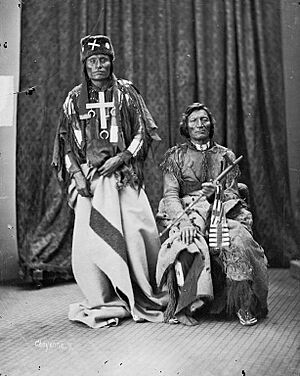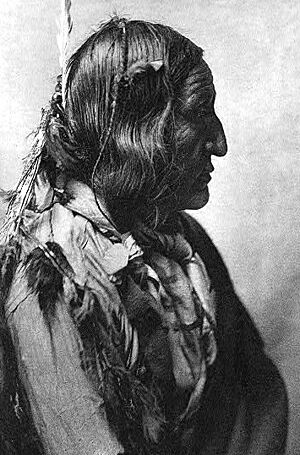Little Wolf facts for kids
Little Wolf (born around 1820, died 1904) was a very important leader of the Northern Cheyenne people. His Cheyenne name was Ó'kôhómôxháahketa, which means Little Coyote. He was known as a great military leader. He also led a famous journey in 1878, helping his people escape from a reservation in Oklahoma to return to their homeland. This event is called the Northern Cheyenne Exodus.
Contents
Who Was Little Wolf?
Little Wolf was born in what is now Montana. By the mid-1840s, he became a respected leader among the Northern Cheyenne. He led a group of brave warriors called the "Elk Horn Scrapers." These warriors fought in important conflicts like Red Cloud's War (1866-1868), which was a fight over the Bozeman Trail.
As a chief, Little Wolf signed the Treaty of Fort Laramie in 1868. He was chosen as one of the "Old Man" chiefs in the Council of Forty-four. This was a very high honor in Cheyenne culture. He was also chosen as the Sweet Medicine Chief. This meant he carried the spirit of Sweet Medicine, a very important hero and spiritual ancestor for the Cheyenne people. Because of this special title, he was expected to always be calm and only think about what was best for his people.
Little Wolf and the Battles
Little Wolf was not at the famous Battle of the Little Bighorn. However, he played a part in events before and after it. Some scouts from his camp found food left by Custer's soldiers. Custer heard about this and mistakenly thought the main Cheyenne and Sioux camps had seen him. This made him rush his attack, hoping to stop the Native Americans from escaping.
After the battle, Little Wolf arrived. Some angry Sioux people thought he might have been helping the white soldiers. But Little Wolf strongly denied this. With the support of his fellow Northern Cheyenne who had fought in the battle, he was saved from harm.
Forced to Move and Escape
In November 1876, Little Wolf and another chief named Dull Knife were camped in Wyoming Territory. On November 25, soldiers led by Colonel Ranald S. Mackenzie attacked them. The Cheyenne were defeated, and Little Wolf and Dull Knife had to surrender.
In 1877, the U.S. government decided to send Little Wolf, Dull Knife, and their people to a reservation in Indian Territory (which is now Oklahoma).
The Great Escape from Oklahoma
Life on the reservation in Oklahoma was very hard for the Northern Cheyenne. Many people got sick with diseases like malaria, and there wasn't enough medicine, food, or warm clothes for the winter. Forty-one people died that winter.
Little Wolf and Dull Knife asked many times if their people could return to Montana. But their requests were always denied. So, in September 1878, Little Wolf and Dull Knife led almost 300 Cheyenne people away from the reservation. They traveled through Kansas, Nebraska, and the Dakota Territory to reach their old home in Montana Territory.
During this long journey, they managed to avoid the U.S. cavalry who were trying to catch them. The two groups split up in Nebraska. Dull Knife's group was eventually forced to surrender. But Little Wolf's group made it all the way to Montana. There, they were finally allowed to stay in their homeland.
Little Wolf's Later Life
Later in his life, Little Wolf worked as a scout for the U.S. Army. He was no longer a chief.
He spent his final years on the Northern Cheyenne Indian Reservation. He passed away in 1904 and is buried in the Lame Deer cemetery, next to Morning Star. George Bird Grinnell, a close friend who wrote about Little Wolf's life, called him "the greatest Indian I have ever known."
Little Wolf's Life Events
- 1820: Little Wolf is born.
- 1856: Involved in an event about a 'stolen' horse at the Platte Bridge.
- 1866: Takes part in the Fetterman Fight.
- 1868: Signs a treaty with the U.S. Government at Fort Laramie.
- 1868: Burns Fort Phil Kearny.
- 1873: Visits Washington, D.C..
- 1876: Takes part in the Dull Knife Fight.
- 1877: Ordered to move south to a reservation in Oklahoma.
- 1878: Leads a famous escape from the reservation and returns to Montana.
- 1879: Becomes a scout for the U.S. military.
- 1880: Is removed as Chief and goes into voluntary exile.
- 1904: Little Wolf dies.
Cheyenne History Timeline
- 17th-18th century: The Cheyenne people moved from Minnesota to North Dakota.
- 1804: Visited by the Lewis and Clark Expedition.
- 1851: The Ft. Laramie Treaty is signed.
- 1859: The Colorado Gold Rush begins.
- 1864: The Colorado War takes place.
- 1864: November, the Sand Creek massacre occurs.
- 1868: The Battle of Washita River takes place.
- 1876: The Battle of the Little Bighorn occurs.
- 1877: The Cheyenne are moved to Indian Territory.
- 1884: A new reservation is created near the Black Hills.
More About the Name "Little Wolf"
The name "Little Wolf" was quite common among American Indians. More than one Cheyenne chief had this name. For example, an earlier Southern Cheyenne chief named Little Wolf was part of a famous horse-stealing raid around 1830.
See also
 In Spanish: Little Wolf para niños
In Spanish: Little Wolf para niños
- Eugene Little Coyote
- Marie Sanchez - a direct descendant of Little Wolf.




